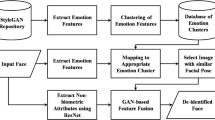Abstract
With the identity information in face data more closely related to personal credit and property security, people pay increasing attention to the protection of face data privacy. In different tasks, people have various requirements for face de-identification (De-ID), so we propose a systematical solution compatible for these De-ID operations. Firstly, an attribute disentanglement and generative network is constructed to encode two parts of the face, which are the identity (facial features like mouth, nose and eyes) and expression (including expression, pose and illumination). Through face swapping, we can remove the original ID completely. Secondly, we add an adversarial vector mapping network to perturb the latent code of the face image, different from previous traditional adversarial methods. Through this, we can construct unrestricted adversarial image to decrease ID similarity recognized by model. Our method can flexibly de-identify the face data in various ways and the processed images have high image quality.
Access this chapter
Tax calculation will be finalised at checkout
Purchases are for personal use only
Similar content being viewed by others
References
Szegedy, C., et al.: Intriguing properties of neural networks. arXiv preprint arXiv:1312.6199 (2013)
Goodfellow, I.J., et al.: Generative adversarial networks. arXiv preprint arXiv:1406.2661 (2014)
Shan, S., et al.: Fawkes: protecting privacy against unauthorized deep learning models. In: 29th USENIX Security Symposium (USENIX Security 2020) (2020)
Maximov, M., Elezi, I., Leal-Taixé, L.: CIAGAN: conditional identity anonymization generative adversarial networks. In: Proceedings of the IEEE/CVF Conference on Computer Vision and Pattern Recognition, pp. 5447–5456 (2020)
Karras, T., Laine, S., Aila, T.: A style-based generator architecture for generative adversarial networks. In: Proceedings of the IEEE/CVF Conference on Computer Vision and Pattern Recognition, pp. 4401–4410 (2019)
Song, Y., Shu, R., Kushman, N., Ermon, S.: Constructing unrestricted adversarial examples with generative models. arXiv preprint arXiv:1805.07894 (2018)
Li, L., Bao, J., Yang, H., Chen, D., Wen, F.: FaceShifter: towards high fidelity and occlusion aware face swapping. arXiv preprint arXiv:1912.13457 (2019)
Chen, X., et al. InfoGAN: interpretable representation learning by information maximizing generative adversarial nets. arXiv preprint arXiv:1606.03657 (2016)
Higgins, I., et al.: beta-VAE: learning basic visual concepts with a constrained variational framework (2016)
Nitzan, Y., Bermano, A., Li, Y., Cohen-Or, D.: Face identity disentanglement via latent space mapping. ACM Trans. Graph. (TOG) 39(6), 1–14 (2020)
Bose, A.J., Aarabi, P.: Adversarial attacks on face detectors using neural net based constrained optimization. In: 2018 IEEE 20th International Workshop on Multimedia Signal Processing (MMSP), pp. 1–6. IEEE (2018)
Kaziakhmedov, E., Kireev, K., Melnikov, G., Pautov, M., Petiushko, A.: Real-world attack on MTCNN face detection system. In: 2019 International Multi-Conference on Engineering, Computer and Information Sciences (SIBIRCON), pp. 0422–0427. IEEE (2019)
Sharif, M., Bhagavatula, S., Bauer, L., Reiter, M.K.: Accessorize to a crime: real and stealthy attacks on state-of-the-art face recognition. In: Proceedings of the 2016 ACM SIGSAC Conference on Computer and Communications Security, pp. 1528–1540 (2016)
Komkov, S., Petiushko, A.: AdvHat: real-world adversarial attack on arcface face id system. arXiv preprint arXiv:1908.08705 (2019)
Zhao, H., Gallo, O., Frosio, I., Kautz, J.: Loss functions for image restoration with neural networks. IEEE Trans. Comput. Imaging 3(1), 47–57 (2016)
Goodfellow, I.J., Shlens, J., Szegedy, C.: Explaining and harnessing adversarial examples. arXiv preprint arXiv:1412.6572 (2014)
Pidhorskyi, S., Adjeroh, D.A., Doretto, G.: Adversarial latent autoencoders. In: Proceedings of the IEEE/CVF Conference on Computer Vision and Pattern Recognition, pp. 14104–14113 (2020)
Nirkin, Y., Keller, Y., Hassner, T.: FSGAN: subject agnostic face swapping and reenactment. In: Proceedings of the IEEE/CVF International Conference on Computer Vision, pp. 7184–7193 (2019)
Heusel, M., Ramsauer, H., Unterthiner, T., Nessler, B., Hochreiter, S.: GANs trained by a two time-scale update rule converge to a local nash equilibrium. arXiv preprint arXiv:1706.08500 (2017)
Zhang, K., Zhang, Z., Li, Z., Qiao, Y.: Joint face detection and alignment using multitask cascaded convolutional networks. IEEE Signal Process. Lett. 23(10), 1499–1503 (2016)
Deng, J., Guo, J., Xue, N., Zafeiriou, S.: ArcFace: additive angular margin loss for deep face recognition. In: Proceedings of the IEEE/CVF Conference on Computer Vision and Pattern Recognition, pp. 4690–4699 (2019)
Xia, W., et al.: GAN inversion: a survey. arXiv preprint arXiv:2101.05278 (2021)
Zhang, R., Isola, P., Efros, A.A., Shechtman, E., Wang, O.: The unreasonable effectiveness of deep features as a perceptual metric. In: Proceedings of the IEEE Conference on Computer Vision and Pattern Recognition, pp. 586–595 (2018)
Acknowledgements
This work was supported by the National Natural Science Foundation of China 61772529, Beijing Natural Science Foundation under Grant 4192058, National Natural Science Foundation of China 61972395 and National Key Research and Development Program of China 2020AAA0140003.
Author information
Authors and Affiliations
Corresponding author
Editor information
Editors and Affiliations
Rights and permissions
Copyright information
© 2021 Springer Nature Switzerland AG
About this paper
Cite this paper
Yang, S., Wang, W., Cheng, Y., Dong, J. (2021). A Systematical Solution for Face De-identification. In: Feng, J., Zhang, J., Liu, M., Fang, Y. (eds) Biometric Recognition. CCBR 2021. Lecture Notes in Computer Science(), vol 12878. Springer, Cham. https://doi.org/10.1007/978-3-030-86608-2_3
Download citation
DOI: https://doi.org/10.1007/978-3-030-86608-2_3
Published:
Publisher Name: Springer, Cham
Print ISBN: 978-3-030-86607-5
Online ISBN: 978-3-030-86608-2
eBook Packages: Computer ScienceComputer Science (R0)




